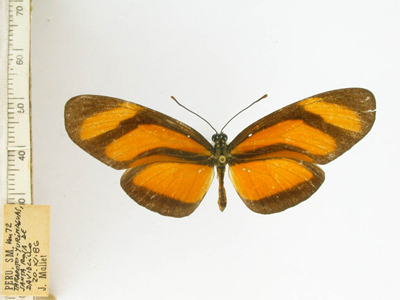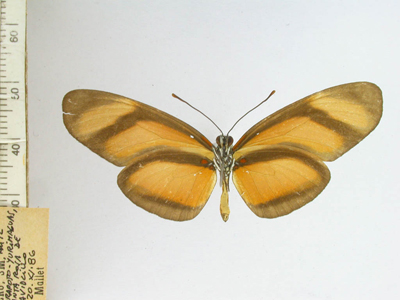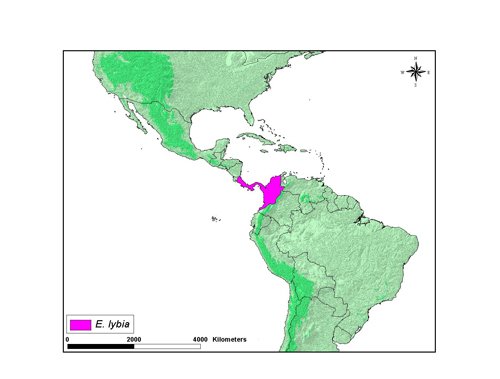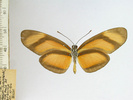Eueides lybia
Margarita BeltránIntroduction
Etymology: In Greek mythology, Lybia, like Ethiopia or Scythia, was one of the mythic outlands that encircled the familiar Greek world of the Hellenes and their "foreign" neighbors. Lybia was also personified as an individual, she was the daughter of Epaphus, King of Egypt, who had three sons by the Libyan Sea-God Poseidon: Belus, Agenor and Lelex (Libya).
Characteristics
Early stages: Eggs are cream colored and approximately 1 x 0.7 mm (h x w). Females usually place eggs singly under older leaves of the host plant. Mature larvae have a brown body with yellow stripes, with black scoli and orange head; length is around 3 cm. Caterpillars are gregarious in small groups (Brown, 1981). Pupae are greenish white with black markings on the wingpads and short spines on the dorsum that are tipped black (DeVries, 1997).
Geographical distribution
Eueides lybia is widely distributed from Central America to the Amazon. The map below shows an approximate representation of the geographic distribution of this species. The original data used to draw these maps are derived from Brown (1979) which is available at Keith S. Brown Jr. (1979). Ecological Geography and Evolution in Neotropical Forests.
Habits
E. lybia occurs from sea level to 1,200 m in tall forests and gaps. Females mate multiply. Adults roost in loose groups at night at 2-10 m above ground, under leaves (Brown, 1981).
Hostplant: E. lybia larvae feed primarily on plants from the subgenera Distephana and Granadilla (Passifloraceae)(Brown, 1981). In Costa Rica E. i. lybioides larvae feed on Passiflora vitifolia (Passifloraceae) (DeVries, 1997).
References
Brown K. S. 1979. Ecologia Geográfica e Evolução nas Florestas Neotropicais. 2 vols. (Tese apresentada à Universidade Estadual de Campinas como parte das exigências de um Concurso de Livre Docência, area de Ecologia). Universidade Estadual de Campinas, Campinas, Brazil. Brown K. S. 1981 The Biology of Heliconius and Related Genera. Annual Review of Entomology 26, 427-456.
DeVries P. J. 1997 The Butterflies of Costa Rica and Their Natural History, Volume I: Papilionidae, Pieridae, Nymphalidae Princeton University Press, Baskerville, USA.
Libya. Wikipedia http://en.wikipedia.org/wiki/Libya_(mythology)[Accessed Aug 16, 2008].
Title Illustrations

| Scientific Name | Eueides lybia lybia |
|---|---|
| Specimen Condition | Dead Specimen |
| View | dorsal |
| Collection | Gerardo Lamas |
| Image Use |
 This media file is licensed under the Creative Commons Attribution-NonCommercial-ShareAlike License - Version 3.0. This media file is licensed under the Creative Commons Attribution-NonCommercial-ShareAlike License - Version 3.0.
|
| Copyright |
©

|
| Scientific Name | Eueides lybia lybia |
|---|---|
| Specimen Condition | Dead Specimen |
| View | ventral |
| Collection | Gerardo Lamas |
| Image Use |
 This media file is licensed under the Creative Commons Attribution-NonCommercial-ShareAlike License - Version 3.0. This media file is licensed under the Creative Commons Attribution-NonCommercial-ShareAlike License - Version 3.0.
|
| Copyright |
©

|
About This Page

University of Cambridge, Cambridge, UK
Correspondence regarding this page should be directed to Margarita Beltrán at
Page copyright © 2009
 Page: Tree of Life
Eueides lybia .
Authored by
Margarita Beltrán.
The TEXT of this page is licensed under the
Creative Commons Attribution-NonCommercial-ShareAlike License - Version 3.0. Note that images and other media
featured on this page are each governed by their own license, and they may or may not be available
for reuse. Click on an image or a media link to access the media data window, which provides the
relevant licensing information. For the general terms and conditions of ToL material reuse and
redistribution, please see the Tree of Life Copyright
Policies.
Page: Tree of Life
Eueides lybia .
Authored by
Margarita Beltrán.
The TEXT of this page is licensed under the
Creative Commons Attribution-NonCommercial-ShareAlike License - Version 3.0. Note that images and other media
featured on this page are each governed by their own license, and they may or may not be available
for reuse. Click on an image or a media link to access the media data window, which provides the
relevant licensing information. For the general terms and conditions of ToL material reuse and
redistribution, please see the Tree of Life Copyright
Policies.
- First online 18 February 2007
- Content changed 04 September 2008
Citing this page:
Beltrán, Margarita. 2008. Eueides lybia . Version 04 September 2008 (under construction). http://tolweb.org/Eueides_lybia/72969/2008.09.04 in The Tree of Life Web Project, http://tolweb.org/











 Go to quick links
Go to quick search
Go to navigation for this section of the ToL site
Go to detailed links for the ToL site
Go to quick links
Go to quick search
Go to navigation for this section of the ToL site
Go to detailed links for the ToL site